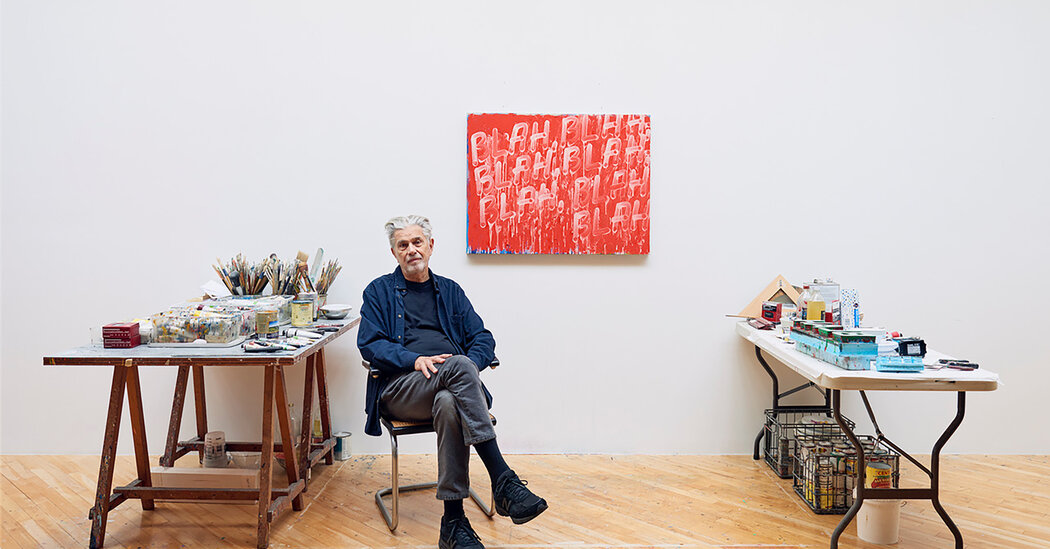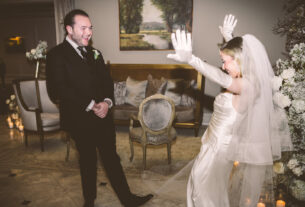Mel Bochner, an artist who produced heady and often witty work in a multitude of mediums, exploring the boundaries of art — and the power of language — in drawing, painting, photography, sculpture, printmaking, books, installations and public art, died on Feb. 12 in Manhattan. He was 84.
His death, in a hospital, was from complications of a fall, Lizbeth Marano, his wife, said.
In 1966, Mr. Bochner (pronounced BOK-ner) was in his 20s, living in a cold-water flat in the East 70s in Manhattan, writing mini art reviews for $2.50 apiece, teaching art history at the School of Visual Arts and trying to figure out what it meant to be an artist. He was making what he thought was “quite awful” work — triangles he cut out of Styrofoam, for example, and covered with fiberglass. The fumes from that process were awful, too, so he stopped.
When S.V.A. asked him to organize a Christmas show of drawings that year, he reached out to his friends Sol LeWitt, Eva Hesse and Robert Smithson as well as other artists he admired, like Carl Andre, and asked them for sketches of their works in progress.
S.V.A. didn’t have the money to frame the drawings, so Mr. Bochner photocopied them — the school had a new Xerox machine — and collected them in four binders, along with copies of articles from Scientific American, mathematical calculations and other bits of information. He set the binders on plain white pedestals and titled the show “Working Drawings and Other Visible Things on Paper Not Necessarily Meant to Be Viewed as Art.”
It was an early salvo in the flourishing movement of conceptual art: the idea that an artwork didn’t need to be an object. Some say it may have been the first conceptual exhibition. Firsts are hard to prove, but it was a watershed moment nonetheless, and Mr. Bochner’s photocopied books inspired generations of artists.
“It was a breakthrough,” said James Meyer, the curator of modern art at the National Gallery of Art in Washington. “Mel was a trailblazer in conceptual art. But his work also complicated the simplistic notion that the idea alone was the art. For Mel, the idea had to take material form. ‘No thought can exist without a sustaining support,’ as he put it.”
Mr. Meyer added: “He always said his work was experimental. It was an investigation. It was about asking questions: ‘If I did this, what would happen?’”
Mr. Bochner began playing with language, making word “portraits” of his friends. He rendered Ms. Hesse as the word “wrap,” which he wrote in the middle of a circular sheet of graph paper, with synonyms for the word swirling around it. He and Mr. Smithson wrote and illustrated an inscrutable article that they conceived as an art piece — and a bit of prank — inspired by the Planetarium at the American Museum of Natural History in Manhattan. They titled it “The Domain of the Great Bear” and convinced Art Voices magazine to publish it. For Arts Magazine, Mr. Bochner wrote an article about the Beach Boys in which he listed personal details about the band members, including their heights and weights.
He was interested in philosophy and mathematics, space and repetition. In one early show, he outlined the walls of a Munich gallery in black tape, notching the tape at three-foot intervals. He once coated a gallery window with soap and then wrote the numbers 1 to 962 in the soap film. He arranged pebbles on gallery floors and wrote on gallery walls.
He crumpled up pieces of graph paper and took photos of them. He assembled toy blocks into curious arrangements and photographed them, too.
He deployed pennies, newsprint, chalk and masking tape — “idiosyncratic, barely-there materials,” as the art critic Roberta Smith of The New York Times put it in a review of a retrospective of Mr. Bochner’s early work at the Yale University Art Gallery in 1995.
“Coupled with his innately beautiful handwriting,” she wrote, those materials gave his spatial and philosophical explorations “a wry and engaging visual life that undermined traditional notions of artistic permanence, craft and value.”
“For all its supposed cerebralness,” Ms. Smith concluded, “Bochner’s early work is adamantly resistant to linguistic parsing. He aimed his concepts almost exclusively at immediate perception, and his mind-twisting fusion of mental and physical space was, and still is, something new.”
Melvin Simon Bochner was born on Aug. 23, 1940, in Pittsburgh, one of three children of Meyer and Minnie (Horowitz) Bochner. His father was a sign painter.
Even as a child, Mel was a gifted artist, attending classes at the Carnegie Museum of Art in Pittsburgh. He often assisted his father, from whom he learned to paint letters freehand. He received a scholarship to attend the Carnegie Institute of Technology, where he was classically trained.
After graduating in 1962, he roamed around a bit, traveling to California and Mexico, working odd jobs, struggling to reconcile being an artist with his working-class background. He spent a few months in Chicago, auditing philosophy courses, before realizing, he said, that he didn’t want to study philosophy — he wanted to make things. In 1964, he headed to New York City.
His first job was as a guard at the Jewish Museum (Brice Marden had just quit, so there was an opening), but he was fired after a year when he was discovered napping behind a Louise Nevelson sculpture. (In those days, he would stay up all night making art and come to work exhausted.)
In 2012, Mr. Bochner returned to the museum with “Strong Language,” a show that focused on his Thesaurus paintings, enormous pieces he began making after the turn of the millennium. These were riffs on existentially urgent words like “Money” and “Contempt” and “Old,” which he rendered gorgeously in bright neon colors, painting synonyms and phrases for each title that marched across the canvas, careering from the conventional to the vulgar. (“Old” concludes with the words “Can’t Get It Up.”) The works are at once comical and profound.
The show included a piece called “The Joys of Yiddish,” a nod to Leo Rosten’s classic book of the same name from which Mr. Bochner collected some of the most vivid and beloved slurs — “nudnick,” “schlemiel” and “schmo” among them — and painted them in yellow on a black background. The colors reference not just classic street signage but, more darkly, the yellow armbands that Nazis forced Jewish people to wear. The words are separated by commas because, as Mr. Bochner explained, a comma indicates that a thought is ongoing. He was using punctuation to point out that antisemitism is never-ending.
“We’re living through a comma right now,” he said at the time.
The next year, the Haus der Kunst in Munich, the neo-Classical museum built by the Nazis in 1933, invited Mr. Bochner to put on a show and to create a frieze of “The Joys of Yiddish” for the building’s front facade. “Isn’t this a kick in the pants?” he recalled thinking, delighted to fill what he described as a terrible hole in contemporary German culture.
In addition to Ms. Marano, Mr. Bochner, who lived in Manhattan, is survived by their daughters, Francesca and Piera Bochner; three grandchildren; his sister, Rita Wolfsohn; and his brother, Arthur.
“In 1970, I wrote on a gallery wall, ‘Language Is Not Transparent,’” Mr. Bochner told curators at the Art Institute of Chicago in 2022, when the museum held a retrospective of his work. “It was a statement that all language has hidden agendas and motives. The first thing that power corrupts is language.”
He continued: “My work doesn’t address political issues directly. In works like ‘Exasperations’” — a series of etchings of phrases one might utter when exasperated, like “So What” — “I want the meaning to dawn on the viewer, not bludgeon them. But, at the same time, I do agree with Charlie Chaplin: ‘If it isn’t funny, it isn’t art.’”





